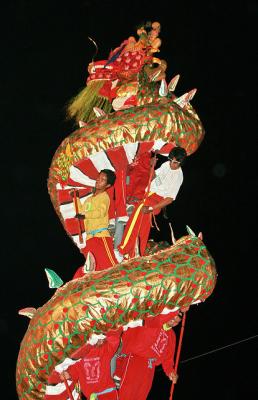 Nous sommes toujours le 26 janvier , il est 19h30 , je suis arrivé sur place ou ont lieu les défilés et dances concernant les évènements du nouvel an chinois . J'ai fait quelques photos , mais par comble de malchance ma nièce qui devait danser , était déjà passé , décidément je suis maudit .Néanmoins vous trouverez ces photos dans un album intitulé "nouvel an chinois".rejoins , mais la journée ètant avancée , je suis rentré à pied dans ma chambre (environ 2/3 kilomètres).
Nous sommes toujours le 26 janvier , il est 19h30 , je suis arrivé sur place ou ont lieu les défilés et dances concernant les évènements du nouvel an chinois . J'ai fait quelques photos , mais par comble de malchance ma nièce qui devait danser , était déjà passé , décidément je suis maudit .Néanmoins vous trouverez ces photos dans un album intitulé "nouvel an chinois".rejoins , mais la journée ètant avancée , je suis rentré à pied dans ma chambre (environ 2/3 kilomètres).
j'ai décidé ce soir là de ne pas prendre de médicament pour dormir , bien mal m'en a pris , car à 5 heures j'étais réveillé ,et la tristesse m'a à nouveau envahie , tout cela fait partie de ma vie maintenant , une vie de merde que j'ai de temps en temps du mal à gèrer .
We are always January 26th, it is 7:30 pm, I'm arrived on the spot or take place the parades and dances concerning the events of the Chinese New Year. I made some photos, but by height of adversity my niece who had to dance, was already crossed, certainly I am cursed .Néanmoins you will find these photos in an entitled album "Chinese New Year" .Noi , François and Quentin joined me already, but the day was advanced , I returned on foot in my room (Approximately 2/3 kilometres).
I decided this evening there not to take medicine to sleep, very badly took me, because at 5 am I was woken, and the sadness again invaded me, all this is a part of my maintaining life, a life of shit which I have from time to time of the evil to manage.
Le calendrier chinois étant un calendrier luni-solaire, la date du Nouvel An chinois dans le calendrier grégorien varie d'une année sur l'autre, mais tombe toujours entre le 21 janvier et le 20 février. C’est, comme tous les commencements de mois lunaires chinois, le premier jour d'une nouvelle lune. Par convention, l'alignement astronomique qui signale la nouvelle lune est déterminé à l’observatoire de la montagne pourpre à Nankin.
Les célébrations, coutumes et tabous de la fête de printemps varient dans les détails selon les régions ou les époques. La pratique générale veut qu'on s'efforce de repartir sur un nouveau pied après s'être débarrassé des mauvaises influences de l’an passé, accompagné de signes de bon augure. On a recours à des objets ou aliments présentant une homophonie avec un mot de sens auspicieux.
Le « passage de l’année » s’effectue dans la nuit du dernier jour du douzième mois. Le mot signifiant année est considéré comme étant à l’origine le nom d'un monstre, qui venait autrefois rôder autour des villages une nuit par an, obligeant les habitants à se calfeutrer et à veiller jusqu’à son départ au petit matin. Les célébrations principales comportent un réveillon comprenant des plats aux noms auspicieux, suivi d’une nuit de veille gage de longévité .
Chinese New Year starts with the New Moon on the first day of the new year and ends on the full moon 15 days later. The 15th day of the new year is called the Lantern Festival, which is celebrated at night with lantern displays and children carrying lanterns in a parade.
The Chinese calendar is based on a combination of lunar and solar movements. The lunar cycle is about 29.5 days. In order to "catch up" with the solar calendar the Chinese insert an extra month once every few years (seven years out of a 19-yearcycle). This is the same as adding an extra day on leap year. This is why, according to the solar calendar, the Chinese New Year falls on a different date each year.
New Year's Eve and New Year's Day are celebrated as a family affair, a time of reunion and thanksgiving. The celebration was traditionally highlighted with a religious ceremony given in honor of Heaven and Earth, the gods of the household and the family ancestors.
The sacrifice to the ancestors, the most vital of all the rituals, united the living members with those who had passed away. Departed relatives are remembered with great respect because they were responsible for laying the foundations for the fortune and glory of the family.
The presence of the ancestors is acknowledged on New Year's Eve with a dinner arranged for them at the family banquet table. The spirits of the ancestors, together with the living, celebrate the onset of the New Year as one great community. The communal feast called "surrounding the stove" or weilu. It symbolizes family unity and honors the past and present generations. 

